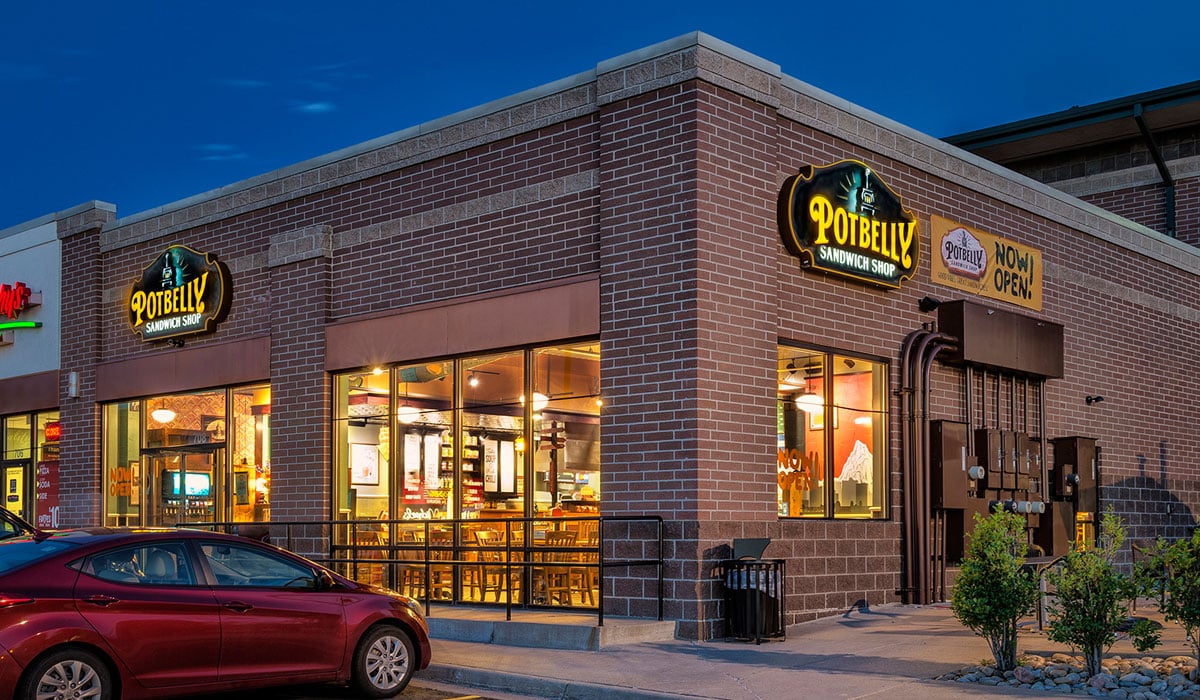Driven by a multi-pronged strategic effort, Potbelly’s sales continued to rise as it heads toward the home stretch of 2021.
The 443-unit sandwich chain’s same-store sales increased 33.7 percent compared to Q3 2020, and lifted 4.5 percent against 2019. Potbelly posted revenues totaling $101.7 million in the third quarter, up from $72.7 million last year, but a decrease from $104.2 million in 2019.
Same-store traffic, which measures transactions, improved by 21.3 percent compared to 2020, with suburban, drive-thru, and university stores reporting positive same-store traffic growth versus 2019. Average check increased 10.2 percent.
“Importantly, our sales and traffic were also driven by the continued implementation of our strategic initiatives during the quarter,” CEO Bob Wright said during the brand’s Q3 earnings call. “Namely our new menu rollout, which was launched nationwide in August, our new tech stack, which launched in early July, and our continued successful investment in digital media and marketing.”
Potbelly’s new menu fueled revenue, traffic, and higher average check in the quarter. Key additions include new sizes for sandwiches, such as the skinny, large, and big sizes, with the latter version featuring more meat and cheese. Three new sandwiches were also introduced to customers; the Chicken Club, Steakhouse Beef, and Avo Turkey (which features hand-sliced fresh avocado) all made initial appearances with solid reviews.
“We’re pleased to report that the launches are performing in line with tested results and delivering a very healthy blend of traffic and check growth,” Wright said. “The social media response to the new menu has been extremely favorable.”
READ MORE: Potbelly’s Profitability Strategy Hits New Stride
Potbelly’s technological development has proven to be successful, as well. The tech stack, which includes a new mobile app, website, digital ordering integration, and Perks loyalty program, is more authentic to the brand and more user-friendly, Wright said during the call.
Senior Vice President and CFO Steve Cirulis said weekly AUVs were more than $20,000—the highest quarterly AUV since 2016. The numbers have continued at that pace through October.
EBITDA was relatively flat at $900,000 compared to Q2, but was up considerably compared to a significant EBITDA loss last year. Adjusted EBITDA was $2.7 million in Q3, an improvement from $1.9 million in the second quarter.
“We are pleased to report this is our fifth consecutive quarter of adjusted EBITDA growth, even in the face of the microeconomic challenges, we, like our industry, faced in the quarter,” he said.
Potbelly also saw meaningful gains in dine-in sales. In-shop mixed nearly 60 percent in Q3, due in part to pent-up demand, said the CFO. Digital business has been successful too, with the brand retaining 82 percent of the business while also increasing sales six percent in dollar terms since the beginning of the year.
“We are particularly excited about our digital retention, even as our customers return to in-shop dining” Cirulis said. “As we have previously discussed, over the long-term, we anticipate a blend of digital and in-shop service modes as the overall environment progresses towards normalization.”
Although central business district and airport shops continue to lag, Wright said they were trending in the right direction and offer upside for Potbelly’s overall growth strategy. Potbelly saw a third consecutive quarter of shop-level profitability, though it was slightly lower sequentially. The CEO said this is due to market-driven labor and other inflationary pressures.
“It’s worth noting that despite the significant environmental margin pressures, we were able to keep the impact to only an 80-basis-point degradation of shop profit, quarter-over-quarter,” he said.
COGS expenses were $28.2 million in Q3 compared to $20.7 million last year. Cirulis said the increase was due to higher costs associated with increased volume, higher discounting associated with the launch of Potbelly’s new app, and overall inflation.
Labor costs were $33.1 million (32.8 percent of shop sales) in the quarter versus $32 million (33 percent of shop sales) in Q2. Cirulis said the increase was due to current labor market headwinds.
“Potbelly is taking aggressive measures to recruit new workers, including referral bonus programs, pay-band modifications, and investing in our applicant tracking system,” he said.
“We believe that we’re trending better than the industry, but the environment obviously remains fluid as we continue to combat this challenging market dynamic. We will remain extremely proactive in our recruiting and staff retention efforts,” he continued.
Later in the call Wright mentioned the brand’s main priorities going forward, which include dealing with labor and staffing, continuing to drive AUV growth, and dealing with inflation.
“We’re taking several mitigating actions to help offset margin pressure,” he said. “This includes strategic price increases and adjusting our contracting approach with our vendor partners to manage food cost inflation.”
Potbelly finished Q3 with 397 company-run stores and 46 franchise units.






